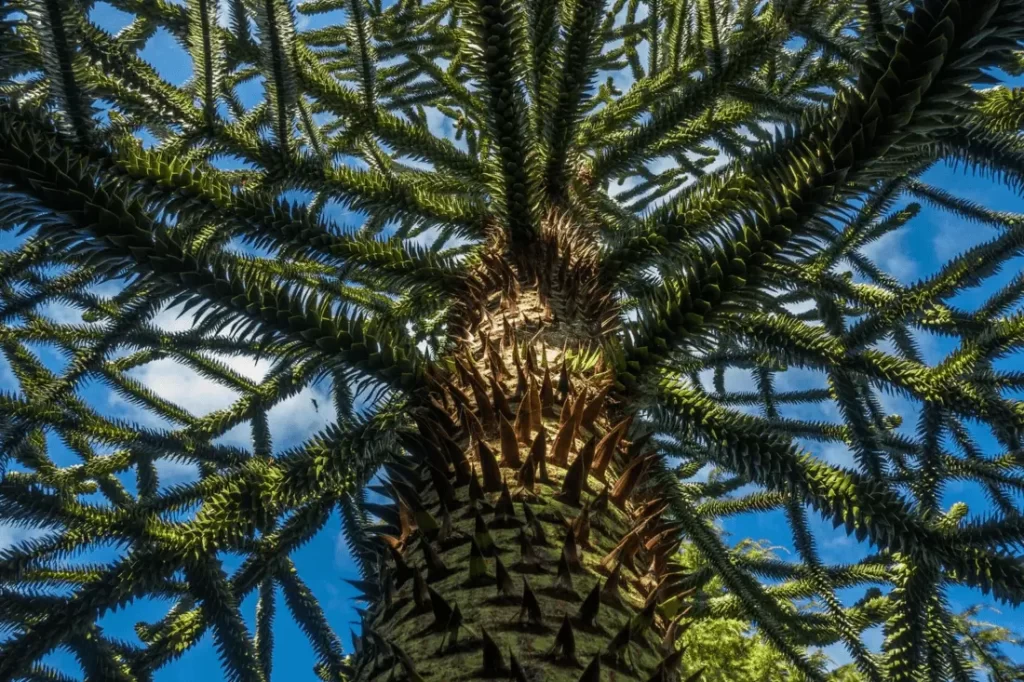The endangered evergreen tree that survived the extinction of the dinosaurs

The old ape problem tree has unique spiny fallen leaves as well as detailed flaky branches. Its uncommon attributes, researchers think, developed as a protection versus towering, long-necked dinosaurs.
Rising to 160 feet (48.8 meters) high as well as able to live for a millennium, the evergreen tree is a survivor from the Jurassic period, greater than 145 million years back.
Araucaria araucana lasted longer than the dinosaurs, yet today clinical specialists think about the tree jeopardized. Grown ape problem trees expand in yards as well as parks all over the world, yet in the wild the varieties just expands along the inclines of Patagonia’s volcanoes in Chile as well as Argentina.
Discharges, land clearance, overgrazing as well as logging have actually diminished the warm woodland where the ape problem tree expands. Its huge seeds are additionally a treasured food resource for a native varieties of bird, the austral parakeet.
The green-hued parrots, in groups of around 15 birds, flit from tree to tree to discover a great area to plump up for the winter months. When the birds hit the mark, their numbers can swell to greater than 100, as well as they make a pig of on ape problem want nuts. The looting parakeets, regardless of their endless cravings for the nuts, in fact might be assisting the ape problem trees endure in Patagonia, current study has actually discovered.

Researchers state the birds function as a barrier versus the hazard positioned by human overharvesting of the nuts. The parakeets normally take the want nuts as well as eat them from a treetop perch lots of feet away. Usually, the birds just partly consume the seeds. As a matter of fact, the partial elimination of the seed layer by parakeets improved the germination rate of ape problem seeds, according to the 2018 research study.
“They (the parakeets) play an important role in the regeneration of the araucaria forests as the partially eaten seeds they leave on the ground are not selected by seed collectors, and they retain their germination potential,” described 2 of the research study writers, Gabriela Gleiser as well as Karina Speziale, scientists at Argentina’s Biodiversity as well as Atmosphere Study Institute at the National College of Comahue.
What’s even more, they claimed through e-mail, the parakeets distribute the seeds, which suggests the trees restore additionally far from the mom plant.
Gleiser as well as Speziale are additionally exploring whether the parakeets, as they flap from branch to spiny branch, cross-pollinate the women cones.
The parakeets aren’t the only locals that consume these nuts. They are additionally a standard resource of food for Chile’s as well as Argentina’s Native Mapuche individuals, that masterfully climb up the significant trees to accumulate seeds as well as extra pound them right into a flour that can be baked right into bread. The nuts, which are bigger than almonds, are additionally consumed much more commonly in both nations, specifically Chile.
The Mapuche can accumulate nuts in their genealogical location; nevertheless, yet, neighborhood authorities limit the quantity of nuts that can be accumulated for individual as well as business objectives as well as need a license, Gleiser as well as Speziale claimed.
“Despite this, many illegal collectors exist who collect without respecting the collection limits,” the scientists included.
“The Araucaria are just like the Mapuche people … even though they have been mistreated, beaten up, we all stay strong,” Petrona Pellao, a participant of the Mapuche Native team, claimed in the CNN docuseries “Patagonia: Life on the Edge of the World.”
The Mapuche are currently replanting Araucaria trees as well as discovering their old genealogical methods. The objective is to assist the Mapuche grow want nuts sustainably as well as enable the Araucaria trees to flourish once more.
Comment
Leave a Reply Cancel reply
You must be logged in to post a comment.





[…] Source link […]